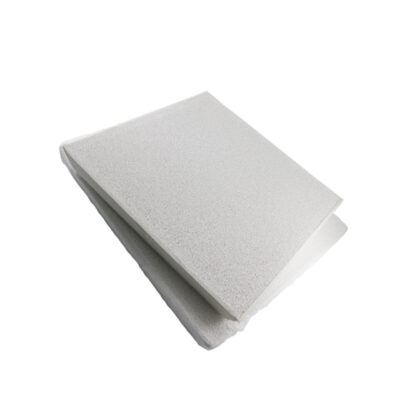It is well known that when melting metals, the molten metals, especially the molten aluminum, usually have solid impurities entrained in suspension, which are harmful to the final metal casting products. After the molten metal solidifies, these entrained solids appear as impurities in the final cast product, making the final product less ductile or poorly glossy and anodized. There can be several sources of these impurities. In order to remove impurities dissolved in the melt, it is preferable to provide an absorption filter or a reaction filter. In general, when selecting porous foam ceramic materials, it should be noted that its filtration capacity or filtration capacity should meet the desired filtration rate of the amount of melt to be filtered, and the accumulation (or accumulation) of the filter should be matched as closely as possible to the wear of the wearing parts.
Porous Foam Ceramic Materials
Porous foam ceramic materials are particularly useful for filtering molten metals for various reasons, one of which is their high filtration efficiency, low cost, ease of use, and the same effect on the basis that the filter can be replaced and thrown away . The fact that these foam ceramic filters are convenient, cheap, and disposable can be used. In addition to the need to provide high-efficiency filter components, it is also required to develop a structure that can easily attach and detach porous molten metal filters from the filter unit.
Since the filter is designed to be used as a throwaway device, the key is to provide an effective structure to install the filter into its easily removable support. The support or filter chamber itself is usually an integral part of the trough, pouring trough or intermediate trough, and should be made of refractory material that is resistant to melting metal and similar to the material used in the standard trough structure. Generally, an elastic sealing mechanism or a peripheral seal such as a gasket is used to seal the filter plate along its periphery. In order to efficiently install the filter plate into the position of the filter chamber, the prior art puts the inclined peripheral surface of the filter plate into the gasket. By applying a vertically downward force on the filter plate to seal the ceramic foam filter plate in a position within the filter chamber, the filter chamber also has a corresponding inclined surface. The commonly used filter components are usually horizontally placed filter plates in the filter chamber.

Porous Ceramic Foam Filter
The porous foam ceramic filter is suitable for the filtration of cast steel and high-temperature alloys, which can control the flow rate of molten steel and achieve a smooth punching pattern. It can also filter non-metal oxides. For example: refractory materials and slag in smelting furnaces and ladles as well as sand, oxides, and secondary oxidation. Filtration can improve casting quality and production efficiency. The foundry can benefit from reducing repair costs such as subsequent welding, grinding and cleaning, and increasing the yield of castings. In addition, filtration can improve the machinability of castings and extend the life of tools.
The effectiveness of the filtration system depends largely on the correct use and placement of the filter. The zirconia filter is produced from partially stabilized zirconia and highly stable refractory materials. It has good thermal shock resistance, chemical resistance, high temperature strength, and creep resistance.
The zirconia filter uses a finer pore size filter to achieve higher filtration efficiency. The frame structure closed with ceramic material on all sides can increase the strength of the filter as a whole and achieve better stability.

